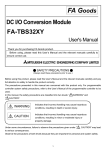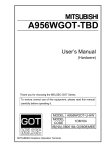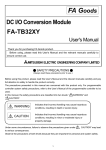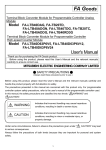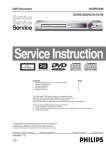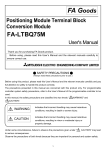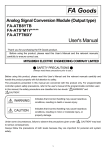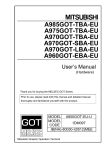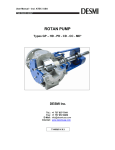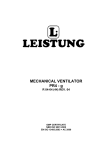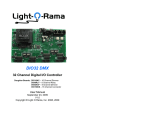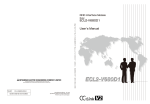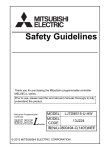Download EMC and Low Voltage Directives Compliant Manual
Transcript
EMC and Low Voltage Directives Compliant Manual Before using, please read "● SAFETY PRECAUTIONS ●" of the User’s Manual of each product. ● EMC and Low Voltage Directives ● Compliance to the EMC Directive, which is one of the EU Directives, has been a legal obligation for the products sold in European countries since 1996 as well as the Low Voltage Directive since 1997. Manufacturers who recognize their products are compliant to the EMC and Low Voltage Directives are required to declare that print a "CE mark" on their products. (1) Authorized representative in Europe Authorized representative in Europe is shown below. Name: Mitsubishi Electric Europe B.V. (EMC C.C. Division) Address: Gothaer strasse 8, 40880 Ratingen, Germany (2) For the conformity to EMC and Low Voltage Directive of FA - Goods To configure a system meeting the requirements of the EMC and Low Voltage Directives when incorporating the FA-Goods (EMC and Low Voltage Directives compliant) into other machinery or equipment, refer to this Manual. Moreover, refer to the manual to compliant to EMC and Low Voltage Directives of PLC used. 1 1.Requirements for compliance with the EMC The EMC Directive specifies that products placed on the market must be so constructed that they do not cause excessive electromagnetic interference (emissions) and are not unduly affected by electromagnetic interference (immunity)". This section summarizes the precautions for compliance with the EMC Directive of the machinery constructed with the FA-goods. In order to use this product in combination with a PLC module, it also needs to fill the demand for EMC conformity of a PLC module. These precautions are based on the requirements and the standards of the regulation, however, it does not guarantee that the entire machinery constructed according to the descriptions will comply with above-mentioned directive. The method and judgement for complying with the EMC Directive must be determined by the person who construct the entire machinery. 1.1 Standards relevant to the EMC Directive (1) Regulations regarding emission Standard Test item Test description Value specified in standard • 30M - 230MHz CISPR16-2-3 Radio waves from Radiated emission the product are EN61131-2: *2 QP:40dBμV/m (10m in measurement range) *1 • 230M - 1000MHz measured. QP:47dBμV/m (10m in 2007 measurement range) CISPR16-2-1, •150k - 500kHz CISPR16-1-2 Noise from the product to the Conducted power line is measured. emission * 2 QP:79dB, Mean:66dB *1 •500k - 30MHz QP:73dB,Mean:60dB *1 QP: Quasi-peak value, Mean: Average value *2 This products are open-type devices (devices designed to be housed inside other equipment) and must be installed inside a conductive control panel. The corresponding tests were conducted with the programmable controller installed inside a control panel. 2 (2) Regulations regarding immunity Standard Test item Test description Value specified in standard EN61000-4-2 Immunity test in which • 8kV Air discharge Electrostatic electrostatic is applied to the • 4kV Contact discharge discharge cabinet of the equipment. 3 immunity* EN61000-4-3 Immunity test in which electric fields 80% AM modulation@1kHz Radiated, are irradiated to the product. • 80M-1000MHz: 10V/m radio-frequency, • 1.4G-2.0GHz: 3V/m electromagnetic field • 2.0G-2.7GHz: 1V/m 3 immunity* EN61000-4-4 Immunity test in which burst • AC/DC main power, I/O power, Electrical fast noise is applied to the power AC I/O (unshielded): 2kV transient/burst line and signal line. • DC I/O, analog, communication: 1kV Immunity test in which • AC power line, AC I/O power, 3 immunity* EN61000-4-5 3 Surge immunity* EN61131-2: lightning surge is applied to AC I/O (unshielded): the power line and signal line. 2kV CM, 1kV DM • DC power line, DC I/O power: 2007 0.5kV CM, DM • DC I/O, AC I/O(shielded),analog*4 , communication: 1kV CM EN61000-4-6 Immunity test in which high 0.15M-80MHz, 80% AM modulation Immunity to onducted frequency noise is applied to @1kHz, 10Vrms disturbances, induced the power line and signal line by radio-frequency fields*3 EN61000-4-8 Immunity test in which the Power-frequency product is installed in magnetic field inductive magnetic field 50Hz/60Hz, 30A/m 3 immunity* EN61000-4-11 Immunity test in which power • Apply at 0%, 0.5 cycles and zerocross point Voltage dips and supply voltage is momentarily • 0%, 250/300 cycles (50/60Hz) interruption interrupted • 40%, 10/12 cycles (50/60Hz) immunity*3 • 70%, 25/30 cycles (50/60Hz) *3 This products are open-type devices (devices designed to be housed inside other equipment) and must be installed inside a conductive control panel. The corresponding tests were conducted with the programmable controller installed inside a control panel. *4 The accuracy of an analog signal isolation conversion module may temporary vary within ±10%. 3 1.2 Installation instructions for EMC Directive This product is an open type device and must be installed inside a control panel for use. This not only ensures safety but also ensures effective shielding of this product-generated electromagnetic noise. Before handling the module, touch a grounded metal object to discharge the static electricity from the human body. Failure to do so may cause the module to fail or malfunction. (1) Control panel • Use a conductive control panel. • When attaching the control panel's top plate or base plate, mask painting and weld so that good surface contact can be made between the panel and plate. • To ensure good electrical contact with the control panel, mask the paint on the installation bolts of the inner plate in the control panel so that contact between surfaces can be ensured over the widest possible area. • Ground the control panel with a thick wire so that a low impedance connection to ground can be Ensured even at high frequencies. • Holes made in the control panel must be 10cm (3.94 inches) diameter or less. If the holes are 10cm (3.94inches) or larger, radio frequency noise may be emitted. In addition, because radio waves leak through a clearance between the control panel door and the main unit, reduce the clearance as much as practicable. Our tests have been carried out on a panel having the damping characteristics of 37 dB max. and 30 dB mean (measured by 3m method with 30 to 300 MHz). (2) Connection of ground wire Ground wire for the module with terminal FG must be connected as described below. • Provide an grounding point near the module with terminal FG. Ground the module with terminal FG of FG terminals (FG : Frame Ground) with the thickest and shortest wire possible. (The wire length must be 30cm (11.81 inches) or shorter.) The FG terminals function is to pass the noise generated in this product to the ground, so an impedance that is as low as possible must be ensured. As the wires are used to relieve the noise, the wire itself carries a large noise content and thus short wiring means that the wire is prevented from acting as an antenna. 4 1.3 Cables The cables extracted from the control panel contain a high frequency noise component. On the outside of the control panel, therefore, they serve as antennas to emit noise. To prevent noise emission, use shielded cables for the cables that are connected to this product and may be extracted to the outside of the control panel. The use of a shielded cable also increases noise resistance. The signal lines (including common line) of this product have noise durability in the condition of grounding their shields by using the shielded cables. If a shielded cable is not used or not grounded correctly, the noise resistance will not meet the specified requirements. (1) Grounding of shield section of shielded cable • Ground the exposed shield section of the shielded cable close to the module. Confirm that the grounded cables are not induced to electromagnetic from the cables, which are not yet grounded. • Ground the exposed shield section of the shielded cable to large area on the control panel. A clamp fitting can be used as shown below. In this case, apply a cover on the painted inner wall surface of the control panel, which comes in contact with the clamp. Note) The method of grounding with a vinyl-coated wire soldered onto the shielded section of the shielded cable as shown below is not recommended. Doing so will raise the high-frequency impedance, resulting in loss of the shielding effect. 5 (2) Grounding cables using a cable clamp Use shielded cables for external wiring of the FA-Goods each modules, and ground the shield section of the shielded cable to the control panel using the AD75CK cable clamp (Mitsubishi)*5. (Ground the shield section within 20 to 30cm from the module.) *5: AD75CK cable clamp is a product of Mitsubishi Electric Corporation . 6 (3) Analog Signal Isolation Conversion module • Install a ferrite core to two non-shielding parts near the PLC of a PLC connection cable, and near an analog signal isolation conversion module. Ferrite core of recommendation : ZCAT2436-1330 manufactured by TDK Corporation *6 *6: ZCAT2436-1330 ferrite core is a product of TDK Corporation. (4) I/O signal cables For I/O signal cables (including common lines), ground the shield sections (in the same way as explained in (1)) when the cables are extended out of the control panel. (5) Power cables for external power supply terminal • Use a CE-marked AC-DC power supply as an external power supply for the the FA-Goods each modules. Install the AC-DC power supply inside the same control panel where the module is installed. Keep the length of a power cable connected to the external power supply terminal to 3m or less. 7 2.Requirements to compliance with the Low Voltage Directive The Low Voltage Directive requires each device that operates with the power supply ranging from 50 to 1000VAC and 75 to 1500VDC to satisfy the safety requirements. This section summarizes the precautions for installation and wiring of the FA-goods to comply with the Low Voltage Directive. In order to use this product in combination with a PLC module, it also needs to fill the demand for the Low Voltage Directive conformity of a PLC module. These descriptions are based on the requirements and standards of the regulation, however, it does not guarantee that the entire machinery manufactured based on the descriptions complies with the above-mentioned directive. The method and judgment for the low voltage directive must be left to the manufacturer's own discretion. 2.1 Standard applied for FA-goods The standard applied for FA-goods is EN50178 safety of devices used in measurement rooms, control rooms, or laboratories. The FA-goods which operate at the rated voltage of 50VAC/75VDC or above are also developed to conform to the above standard. The modules which operate at the rated voltage of less than 50VAC/75VDC are out of the Low Voltage Directive application range. For products with the CE mark, refer to the "Product Information" menu of the MEEFAN homepage. 2.2 Power supply The insulation specification of this product was designed assuming installation category II. Be sure to use the installation category II power supply to this product. The installation category indicates the durability level against surge voltage generated by a thunderbolt. Category I has the lowest durability; category IV has the highest durability. Category II indicates a power supply whose voltage has been reduced by two or more levels of isolating transformers from the public power distribution. 8 2.3 Control panel This product is an open type device (a device designed to be housed inside other equipment) and must be installed inside a control panel for use. (1) Electrical shock prevention The control panel must be handled as shown below to protect a person who does not have adequate knowledge of electricity from an electric shock. • Lock the control panel so that only those who are trained and have acquired enough knowledge of electric facilities can open the control panel. • The control panel must have a structure which automatically stops the power supply when the box is opened. • For electric shock protection, use IP20 or greater control panel. (2) Dustproof and waterproof features The control panel also has the dustproof and waterproof functions. Insufficient dustproof and waterproof features lower the insulation withstand voltage, resulting in insulation destruction. The insulation in this product is designed to cope with the pollution level 2, so use in an environment with pollution level 2 or below. Pollution level 1: An environment where the air is dry and conductive dust does not exist. Pollution level 2: An environment where conductive dust does not usually exist, but occasional temporary conductivity occurs due to the accumulated dust. Generally, this is the level for inside the control box equivalent to IP54 in a control room or on the floor of a typical factory. Pollution level 3: An environment where conductive dust exits and conductivity may be generated due to the accumulated dust. An environment for a typical factory floor. Pollution level 4: Continuous conductivity may occur due to rain, snow, etc. An outdoor environment. As shown above, this product can realize the pollution level 2 when stored in a control panel equivalent to IP54. 9 2.4 Grounding Use module with terminal FG in an grounding status. Functional grounding : Improves the noise resistance. 2.5 External wiring (1) Module power supply and external power supply For the Terminal module and the Analog Signal Isolation Conversion module which requires 24VDC as module power supply, the 5/12/24/48VDC I/O Conversion module, and the Analog Terminal Block Conversion module and the High-Speed Counter Module Terminal Block Conversion Module and the Positioning Module Terminal Block Conversion module and the GOT goods which requires the external power supply, use the 5/12/24/48VDC circuit which is doubly insulated from the hazardous voltage circuit or use the power supply whose insulation is reinforced. (2) External devices When a device with a hazardous voltage circuit is externally connected to this product, use a model whose circuit section of the interface to this product is intensively insulated from the hazardous voltage circuit. 50D-FA9010-108-A Developed March 2013 10










